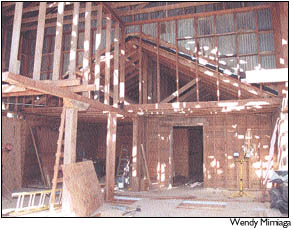|
April 12, 2001
By Jim Mimiaga The degree to which local governments will have control over managing growth within their own communities depends on the Colorado legislature’s willingness to adopt a bill addressing the issue. But so far three growth-control bills introduced this session at the urging of Colorado Gov. Bill Owens have either fallen by the wayside or face obstacles in reaching a compromise between developers and open-space advocates trying to prevent urban sprawl. Senate Bill 148, which would have directed every community to develop master growth plans with frequent review requirements, has already failed to get through the House State Affairs Committee. The bill, dubbed "Amendment 24 lite," was a scaled-down version of that ballot initiative, which would have required voter approval of growth zones that had to have access to central sewer and water systems. The amendment overwhelmingly failed last fall after heavy opposition from developers and property rights advocates. House Bill 1225, now being debated in the Senate, would require urban service areas to be developed with an eye on sufficient infrastructure that anticipates growth into the next 20 years. It would apply for cities of more than 2,000 and counties of more than 10,000; put limited restrictions on development; and encourage individual communities to plan independently from surrounding ones. House Bill 1305 is a generic growth control measure that would be brought up if the other bills die. Rep. Mark Larson, R-Cortez, said he was surprised that SB 148 was killed so early in committee, agreeing that its demise was premature. "It had no chance to be debated so we could try and get a sense of how the two bill could come together," he said. Larson was confident HB 1225 "would live" and liked that fact that "it does not stymie growth, and forces local governments to address growth issues where some have not." "Montezuma and La Plata counties have managed growth whereas in Archuleta County they have not." The bill’s chances depend on how sincerely lawmakers want to control growth in a state that saw 1 million people arrive in the last 10 years, Larson said, noting that "we have to do something." If they do, how balanced the bill becomes "after it is tossed back and forth" between both houses will determine its fate. That’s essential because without an acceptable compromise, the result may be another ballot initiative, which, if passed by voters, would amend the state constitution, forcing all Colorado counties and towns to comply. Ballot initiatives can be put on the ballot by citizens who garner enough signatures in support of it. John Fielder, the nature photographer who lobbied for Amendment 24, says going that route is looking more likely, now that SB 148 was killed. "We supported that bill and it was more moderate than our proposal last year," Fielder said. "But HB 1225 is a travesty; it is basically a developers bill of rights." Fielder criticized HB 1225 as "unacceptable because it puts the burden on governments to comply with what developers want in the planning process, where now developers have to prove that they are conforming with that planning process." Critics of the bill also argue that it takes away the power of local governments to regulate growth, for instance making it difficult for them to declare a moratorium on development if it gets uncontrollable, or charge impact fees. "This shows how biased some legislators are against growth management," Fielder said. "They will pay the price if they do not get something done that is acceptable because if not it will make it so easy for the citizens to come back and get something passed under the initiative process." Larson said that he did not believe HB 1225 would have much of an affect on communities with already substantial controls in place. That is the case here, said Montezuma County Administrator Tom Weaver. He said that the county land-use code, passed in 1998, addresses development fairly, but with restrictions. "What they are calling for we already have in place," Weaver said, conceding that more work needs to be done establishing urban service zones around Cortez, Dolores and Mancos. "We’re not dealing with those larger populations, so it does not affect us as much," he said. "One-size-fits-all ballot initiatives will never work because as a government we have to evolve; when we reach 50,000 people the issues will be different and we need to be able to react." Weaver said that planners have to be careful not to penalize "the last guy who decides to develop," without some kind of mechanism for compensation. "There is no free lunch here — it is not fair to say to someone ‘you can’t develop your ranch because someone else is enjoying looking at your open space.’" |
||
|
Copyright © 2001 the Cortez Journal.
All rights reserved. |
